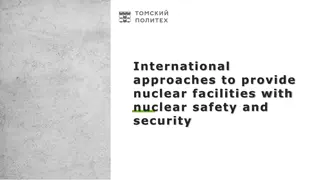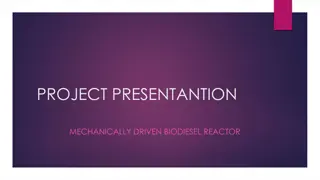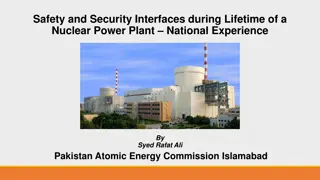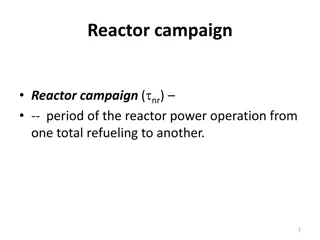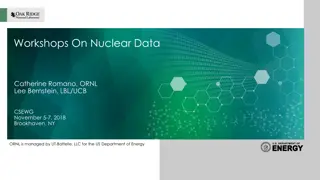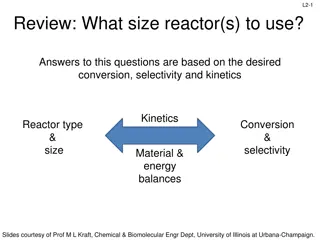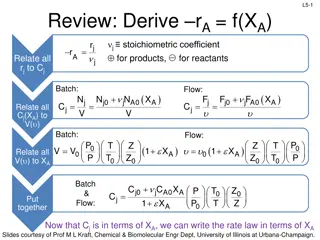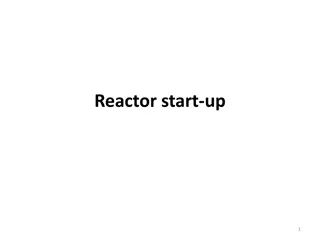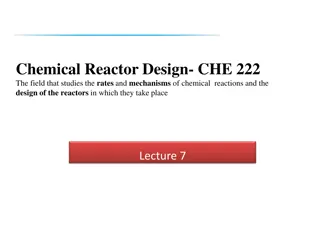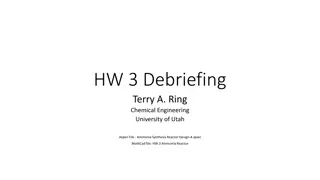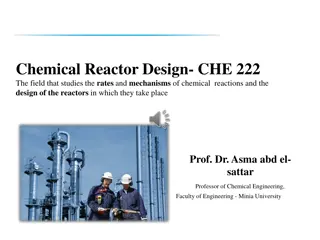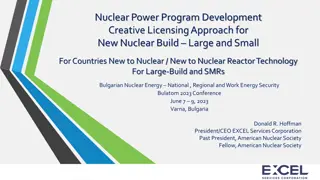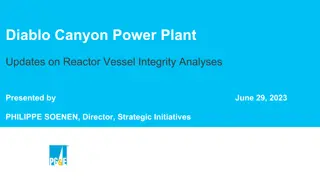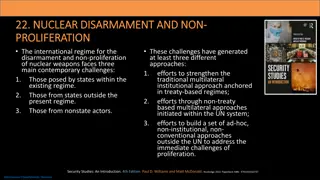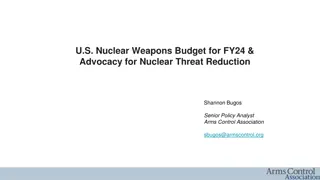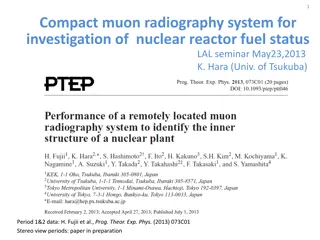Nuclear Reactor Testing and Validation Methodologies
The content discusses the importance of sub-scale testing for licensing support, covering regulatory requirements, evaluation methodologies, and the use of computer models for predicting reactor behavior. It emphasizes the significance of testing data for computer code validation and performance demonstration in licensing processes, with specific focus on phenomena identification, assessments, and uncertainty quantification.
Download Presentation

Please find below an Image/Link to download the presentation.
The content on the website is provided AS IS for your information and personal use only. It may not be sold, licensed, or shared on other websites without obtaining consent from the author.If you encounter any issues during the download, it is possible that the publisher has removed the file from their server.
You are allowed to download the files provided on this website for personal or commercial use, subject to the condition that they are used lawfully. All files are the property of their respective owners.
The content on the website is provided AS IS for your information and personal use only. It may not be sold, licensed, or shared on other websites without obtaining consent from the author.
E N D
Presentation Transcript
Sub-Scale Strategy Scaling Methodology 28 June 2017 Gustafson .1
Sub-Scale Testing for Licensing Support Licensing Basis Testing: Tests required to support NRC regulatory approval for construction permit and operating license for NTP-GTF. Purposes include: Assess reactor performance during accident scenarios Obtain data for computer code validation Two main types of licensing basis testing Characterization tests such as reactor power simulation (point kinetics), reactor protection system and engineered safety features Design basis event tests such as overheating and overcooling transients NRC has specific expectations for computer code validation which drive requirements for licensing basis testing, including critical aspects such as facility scaling and I&C/data stream quality NTP-GTF will be licensed largely based on performance demonstrated in sub-scale tests, as well as the simulation results from computer models whose fidelity has been corroborated by code-to-data comparisons using sub-scale test results. .2
Regulatory Guide 1.203, 2005 Evaluation Methodology Development and Assessment Process (EMDAP) 20 Step Procedure Decision-Making derived from Phenomenological Identification and Ranking Table (PIRT) o Adequacy of tools o Development of Assessment Matrix o Identification of Uncertainties Systematic process for establishing the fidelity of computer models used to predict the behavior of nuclear reactor systems. .3
Top-Down/Bottom-Up Methodology Production Analyses of Record Plant Type Event F.o.M. Analysis Guidelines PIRT S.o.K. Code Selection Scaling Analysis Similarity Requirements Validation Quantify Sensitivity/ Importance Uncertainty Quantification & Analysis Modeling Guidelines Verification Similarity and Scaling serves both Testing and Analysis .4
V&V Interface to Evaluation Model Modeling Guidelines Software Requirements Test Data Software V&V Plan/ Results Analysis Guidelines Modeling Guidelines Analyses of Record Software Design Docs Benchmarks Software QA Documents Evaluation Model Code Assessment .5
Use of Test Data Develop Analytical Model of the Tests Model physical facility Using: Design data Code-specific modeling Guidelines Match Test B.C.s and steady state performance (i.e. DPs/Flow) Identify and resolve code deficiencies Benchmark Model Against Test Data of Simulated Transients and Accidents Confirm that code(s) adequately predicts important phenomena .6
Suggested Near Term Priorities Focus on Sub-scale Exhaust Capture System Test Establish scaling basis Prepare test plan Define facility/configuration For key systems: Define requirements Prepare PFDs Perform preliminary sizing analysis Create Product/Work Breakdown Structure (P/WBS) Establish preliminary schedule for facility design facility mods, equipment procurement, installation, and check-out, and testing, with responsibilities assigned .7
NTP Testing Development Timeline Today s focus .8
Sub-Scale Test System Identification NTP GROUND TEST FACILITY CONTROL ROOM SHIELDING SIMULATOR ELECTRICAL SECURITY RADIOACTIVE WASTE MANAGEMENT AUXILIARY SUPPORT SYSTEMS H2 / REACTOR COOLANT DIGITAL CONTROL FUEL HANDLING & STORAGE EXHAUST CAPTURE REACTOR DATA GAS RAD WASTE MANAGEMENT H2 SUPPLY & INJECTION FUEL & FUEL ELEMENTS AQUISITION LAYER FRESH FHS TEST CELL GAS SUPPLY FACILITY PROTECT LAYER LIQUID RAD WASTE MANAGEMENT CONTROL DRUMS EXHAUST DIFFUSER WATER SUPPLY TURBO PUMP SPENT FHS NOZ & SUPPORT COOLING FACILITY CONTROL LAYER IGNITION & AFTERBURN- ING SOLID RAD WASTE MANAGEMENT FIRE REFLECTOR PROTECTION TEST ARTICLE CONTROL LAYER FLAMMABLE GAS MONITORING Core Flow Distribution POST IGNITION COOLING MODERATOR DECAY HEAT REMOVAL NUCLEAR INSTRUM RADIATION MONITORING EXHAUST CW AIR SUPPLY KEY: EMERGENCY H2 CORE COOLING CHILLED WATER SUPPLY Subscale 11 VESSEL DEBRIS TRAP WASTE WATER Subscale 13 EFFLUENT WATER HANDLING ULTIMATE HEAT SINK NOZZLE SAMPLING Subscale 17 Subscale Sup EFFLUENT GAS HANDLING NONRAD DRAIN SYSTEM RADIOLOGICAL DRAIN Not Subscale COMMUNICA- TION SYSTEMS VENTILATION SYSTEMS .9


